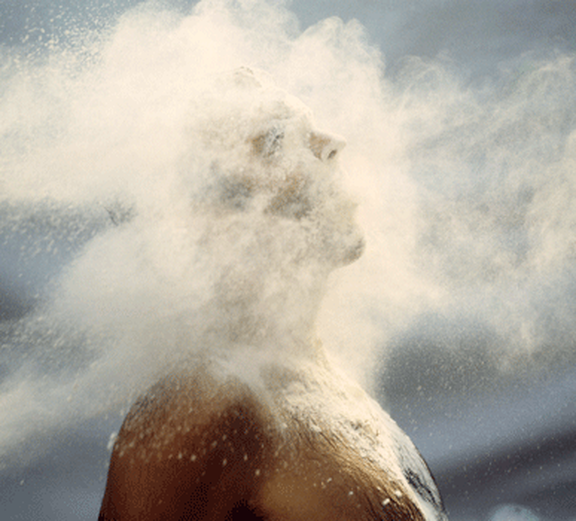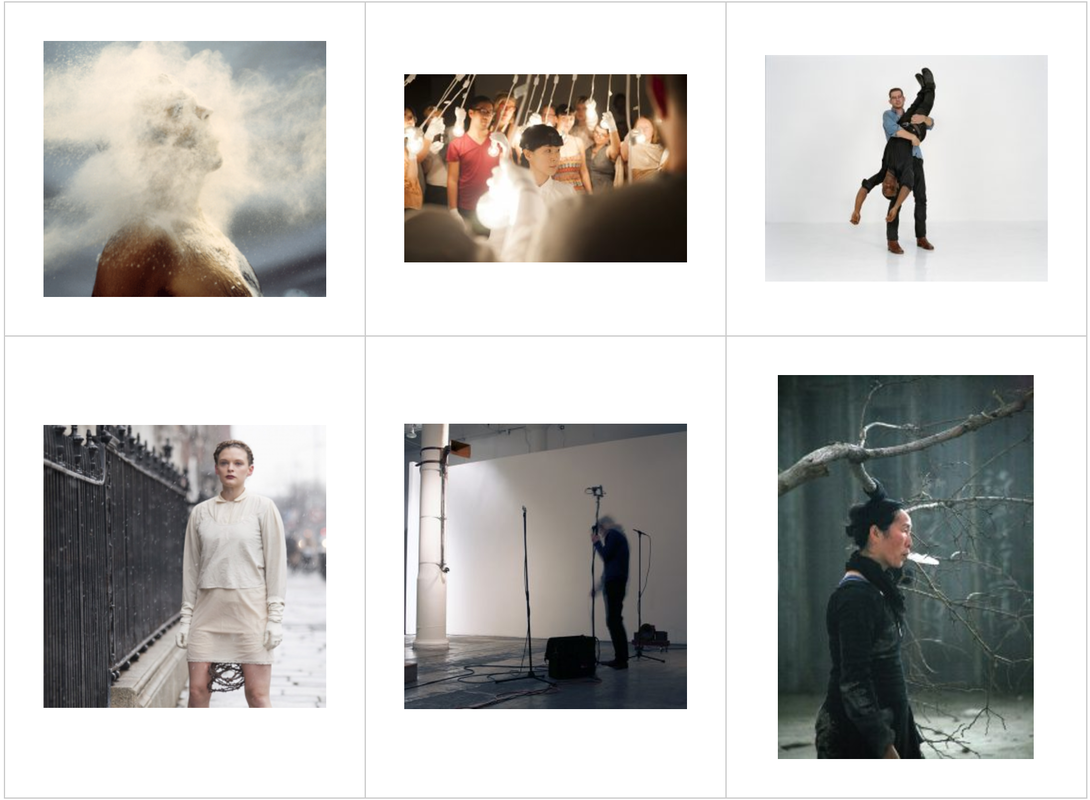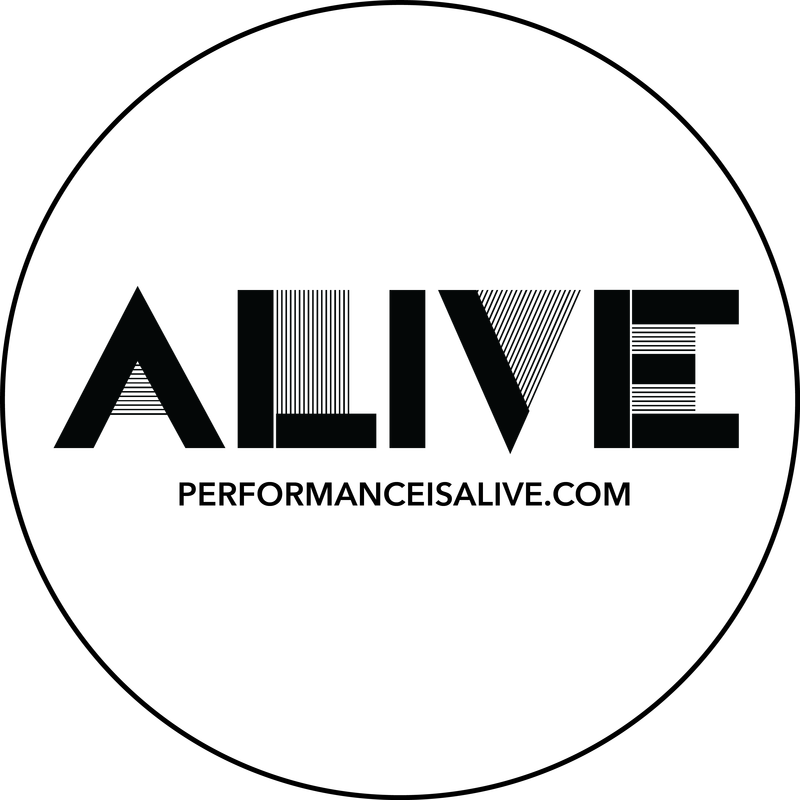 Murakami Saburo, Passing Through, 1956. Performance views, 2nd Gutai Art Exhibition, Ohara Kaikan, Tokyo, ca. October 11–17, 1956. Photo: Otsuji Seiko Collection, Musashino Art University Museum & Library, Tokyo. © Otsuji Seiko and Murakami Makiko. Courtesy Musashino Art University Museum & Library. Photo: Otsuji Kiyoji. BEYOND ABSTRACTION Summer Performance Art Show at Fergus McCaffrey By Ian Deleón “Ruins unexpectedly welcome us with warmth and friendliness; they speak to us through their beautiful cracks and rubble”.1 For six weeks this summer, Fergus McCaffrey gallery in Chelsea, NYC will present a unique program of more than twenty-five live performances by internationally acclaimed and emerging artists Máiréad Delaney, Hee Ran Lee, Daniel Neumann, Clifford Owens, Nigel Rolfe, and Liping Ting.  Nigel Rolfe Dust in Face, 2008 Detail of performance work from 1980. Giclée print on archival paper. 19 5/8 x 19 5/8 inches (50 x 50 cm). © Nigel Rolfe; Courtesy of Fergus McCaffrey, New York. Nigel Rolfe Dust in Face, 2008 Detail of performance work from 1980. Giclée print on archival paper. 19 5/8 x 19 5/8 inches (50 x 50 cm). © Nigel Rolfe; Courtesy of Fergus McCaffrey, New York. REMAINS, curated by Tif Robinette, brings together site-specific work from these six artists whose corporeal relationship to raw materials feels like the kind of fresh, embodied and impassioned protest we need against our “severe present”.2 Works on paper, multimedia installations, and interactive sound will also be on display, giving viewers an opportunity to experience performative objects in a variety of states: before, during, and after their activations. While REMAINS comes as a bit of a departure for FM gallery, the show’s clever organizing is well suited to contextualize the work of its invited artists alongside those which the gallery represents. Primarily, this creates a rare opportunity to highlight the often overlooked lineage between performance artists of today and Japan’s postwar avant-garde Gutai movement. Recognized for its scholarship around Gutai, FM gallery is primed to illuminate the history of this influential group, which predated Fluxus, Happenings, and even the Nouveau Réalisme of Yves Klein. Misread and glossed over in many histories of performance art, Gutai’s preoccupation with the idea of the human spirit “shaking hands”3 with the “scream of matter”4, feels like an appropriate foundation from which to regard the work of the artists in REMAINS. From the press release: Nigel Rolfe uses finely ground natural minerals to create gestured marks on himself, nearby materials, and the space around him. After the performance, the powder remains, a suggestion of the symbolic dust we all emerge from and to which we all return. The often brightly colored pigments in Rolfe’s work contrast with the rich, dark coffee grounds of Clifford Owens’s scatological marks on paper, referencing the profanity of the body. The motions of his actions can be seen on the surface of the paper and reimagined long after the performance is past. Unlike Owens’s use of paper as a surface on which to make an embodied mark, Liping Ting’s Paper Timing / Stone Timing is marked by the slow action of crawling through a mountain of crumpled paper, with contact microphones amplifying her voice and the sound of her movement. Ting’s ongoing investigation into the interplay between her body and language will layer over time as she marks the windows with texts and symbols during a series of durational performances. Máiréad Delaney’s physically strenuous performances put her in a precarious position; she uses her body as a tool in a form of protest, referencing the body through logs cut with bone saws, the cracked pelvis of a heifer, and long branches of wild thorns. In Hee Ran Lee’s work, 50 Bulbs, the audience members become collaborators in the performance, and they each hold the safety of the artist in their hands when she requests that they swing lightbulbs at her head. The resulting effects—the extinguishing of light, breaking of glass, and puffs of smoke surrounding the artist—make the audience active participants, not passive spectators. Also uniquely engaging the audience, Daniel Neumann’s sound installation, Phase Field, invites the viewer toward the site-specific modified speaker-objects, with the sound growing louder and softer in relation to each person’s physical relationship to the work. 1-4. Yoshihara Jirō, translated by Reiko Tomii, Gutai Art Manifesto, 1956
1 Comment
|
CONTRIBUTORSIan Deleón Archives
July 2023
|
|
MISSION // Based in Brooklyn, NYC, PERFORMANCE IS ALIVE is an online platform featuring the work and words of current performance art practitioners. Through interviews, reviews, artists features, sponsorship and curatorial projects, we aim to support the performance community while offering an access point to the performance curious.
Performance Is Alive is a fiscally sponsored project of Fractured Atlas, a 501(c)(3) charity. Contributions made payable to Fractured Atlas for the purposes of Performance Is Alive are tax-deductible to the extent permitted by law. |



